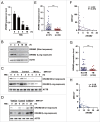MIR144* inhibits antimicrobial responses against Mycobacterium tuberculosis in human monocytes and macrophages by targeting the autophagy protein DRAM2
- PMID: 27764573
- PMCID: PMC5324854
- DOI: 10.1080/15548627.2016.1241922
MIR144* inhibits antimicrobial responses against Mycobacterium tuberculosis in human monocytes and macrophages by targeting the autophagy protein DRAM2
Abstract
Autophagy is an important antimicrobial effector process that defends against Mycobacterium tuberculosis (Mtb), the human pathogen causing tuberculosis (TB). MicroRNAs (miRNAs), endogenous noncoding RNAs, are involved in various biological functions and act as post-transcriptional regulators to target mRNAs. The process by which miRNAs affect antibacterial autophagy and host defense mechanisms against Mtb infections in human monocytes and macrophages is largely uncharacterized. In this study, we show that Mtb significantly induces the expression of MIR144*/hsa-miR-144-5p, which targets the 3'-untranslated region of DRAM2 (DNA damage regulated autophagy modulator 2) in human monocytes and macrophages. Mtb infection downregulated, whereas the autophagy activators upregulated, DRAM2 expression in human monocytes and macrophages by activating AMP-activated protein kinase. In addition, overexpression of MIR144* decreased DRAM2 expression and formation of autophagosomes in human monocytes, whereas inhibition of MIR144* had the opposite effect. Moreover, the levels of MIR144* were elevated, whereas DRAM2 levels were reduced, in human peripheral blood cells and tissues in TB patients, indicating the clinical significance of MIR144* and DRAM2 in human TB. Notably, DRAM2 interacted with BECN1 and UVRAG, essential components of the autophagic machinery, leading to displacement of RUBCN from the BECN1 complex and enhancement of Ptdlns3K activity. Furthermore, MIR144* and DRAM2 were critically involved in phagosomal maturation and enhanced antimicrobial effects against Mtb. Our findings identify a previously unrecognized role of human MIR144* in the inhibition of antibacterial autophagy and the innate host immune response to Mtb. Additionally, these data reveal that DRAM2 is a key coordinator of autophagy activation that enhances antimicrobial activity against Mtb.
Keywords: AMPK; DRAM2; MIR144*; Mycobacterium tuberculosis; tuberculosis.
Figures








Similar articles
-
Silencing miR-125b-5p attenuates inflammatory response and apoptosis inhibition in mycobacterium tuberculosis-infected human macrophages by targeting DNA damage-regulated autophagy modulator 2 (DRAM2).Cell Cycle. 2020 Nov;19(22):3182-3194. doi: 10.1080/15384101.2020.1838792. Epub 2020 Oct 30. Cell Cycle. 2020. PMID: 33121314 Free PMC article.
-
MiR-23a-5p modulates mycobacterial survival and autophagy during mycobacterium tuberculosis infection through TLR2/MyD88/NF-κB pathway by targeting TLR2.Exp Cell Res. 2017 May 15;354(2):71-77. doi: 10.1016/j.yexcr.2017.03.039. Epub 2017 Mar 19. Exp Cell Res. 2017. PMID: 28327409
-
MicroRNA-125a Inhibits Autophagy Activation and Antimicrobial Responses during Mycobacterial Infection.J Immunol. 2015 Jun 1;194(11):5355-65. doi: 10.4049/jimmunol.1402557. Epub 2015 Apr 27. J Immunol. 2015. PMID: 25917095
-
miRNAs in immune responses to Mycobacterium tuberculosis infection.Cancer Lett. 2018 Sep 1;431:22-30. doi: 10.1016/j.canlet.2018.05.028. Epub 2018 May 25. Cancer Lett. 2018. PMID: 29803788 Review.
-
Immunoevasion and immunosuppression of the macrophage by Mycobacterium tuberculosis.Immunol Rev. 2015 Mar;264(1):220-32. doi: 10.1111/imr.12268. Immunol Rev. 2015. PMID: 25703562 Review.
Cited by
-
MicroRNA-27a controls the intracellular survival of Mycobacterium tuberculosis by regulating calcium-associated autophagy.Nat Commun. 2018 Oct 16;9(1):4295. doi: 10.1038/s41467-018-06836-4. Nat Commun. 2018. PMID: 30327467 Free PMC article.
-
The Macrophage Response to Mycobacterium tuberculosis and Opportunities for Autophagy Inducing Nanomedicines for Tuberculosis Therapy.Front Cell Infect Microbiol. 2021 Feb 8;10:618414. doi: 10.3389/fcimb.2020.618414. eCollection 2020. Front Cell Infect Microbiol. 2021. PMID: 33628745 Free PMC article. Review.
-
Understanding the molecular regulatory mechanisms of autophagy in lung disease pathogenesis.Front Immunol. 2024 Oct 31;15:1460023. doi: 10.3389/fimmu.2024.1460023. eCollection 2024. Front Immunol. 2024. PMID: 39544928 Free PMC article. Review.
-
MicroRNA-144 promotes remote limb ischemic preconditioning-mediated neuroprotection against ischemic stroke via PTEN/Akt pathway.Acta Neurol Belg. 2021 Feb;121(1):95-106. doi: 10.1007/s13760-020-01500-5. Epub 2020 Sep 22. Acta Neurol Belg. 2021. PMID: 32960423
-
Interaction among inflammasome, autophagy and non-coding RNAs: new horizons for drug.Precis Clin Med. 2019 Sep;2(3):166-182. doi: 10.1093/pcmedi/pbz019. Epub 2019 Oct 1. Precis Clin Med. 2019. PMID: 31598387 Free PMC article. Review.
References
-
- Deretic V. Autophagy in immunity and cell-autonomous defense against intracellular microbes. Immunol Rev 2011; 240:92-104; PMID:21349088; http://dx.doi.org/10.1111/j.1600-065X.2010.00995.x - DOI - PMC - PubMed
-
- Levine B, Mizushima N, Virgin HW. Autophagy in immunity and inflammation. Nature 2011; 469:323-35; PMID:21248839; http://dx.doi.org/10.1038/nature09782 - DOI - PMC - PubMed
-
- Cemma M, Brumell JH. Interactions of pathogenic bacteria with autophagy systems. Curr Biol 2012; 22:R540-5; PMID:22790007; http://dx.doi.org/10.1016/j.cub.2012.06.001 - DOI - PubMed
-
- Deretic V. Autophagy, an immunologic magic bullet: Mycobacterium tuberculosis phagosome maturation block and how to bypass it. Future Microbiol 2008; 3:517-24; PMID:18811236; http://dx.doi.org/10.2217/17460913.3.5.517 - DOI - PMC - PubMed
-
- Manzanillo PS, Ayres JS, Watson RO, Collins AC, Souza G, Rae CS, Schneider DS, Nakamura K, Shiloh MU, Cox JS. The ubiquitin ligase parkin mediates resistance to intracellular pathogens. Nature 2013; 501:512-6; PMID:24005326; http://dx.doi.org/10.1038/nature12566 - DOI - PMC - PubMed
MeSH terms
Substances
LinkOut - more resources
Full Text Sources
Other Literature Sources
Molecular Biology Databases
Research Materials
